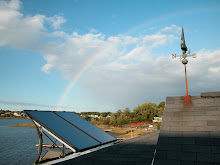Wednesday, January 13, 2010
Efficient Seed Propagation Lights
My wife operates a small Certified Naturally Grown farm. She calls me her "farm hand." I guess the title fits as my responsibilities include those similar to what a farm hand would do; rototilling, bark chipping, fetching compost and building hoop houses and cold frames. Since I don't get paid for my services (other that by delicious "locally grown" veggies) I need a title. I don't care too much for the title she gave me, so I am to be known as the self-anointed Director of Energy Consciousness. She has decided to implement lighting for seed propagation. I am leery of using the term "grow lights" in fear of ending up on some DEA watch list, but that is what they are. After much research on lighting of this sort, I have determined that a mix of T5, T8 and T12 fluorescent lights will serve her best. The factors I considered most important were lumens per watt, cost and availability and environmental impact. T5 lights give off more light per watt and are more environmentally conscious in regards to mercury, but they are expensive and not available locally and would have to be ordered. Fortunately, she has a 2' T5 "sunlight" lamp which I modified to be used for her intended purpose. Since we have some older 4' T12 lights, I felt is was best to modify them with reflectors and mount them over a growing table. Their light output per watt is considerably lower than the newer T5's and T8's, but I felt it was best to use them until the end of their lives to avoid prematurely having to contend with the associated mercury issues, plus there was no expense involved. The remaining lights in the growing system are T8 lights. The light output per watt is close to the T5's and are readily available at the local home improvement center. I bought some Energy Star rated 4' T8 fluorescent shop lights with hanging chains and a power cord for less than $10 each. The 32 watt bulbs produce 20,000 lumens. I mixed some 5,000K "sunlight" bulbs with some 6,500K "daylight" bulbs to average the 5,500K needed for optimum growing with a suitable blend of light in the blue and red ranges. Now I just have to build a growing rack to hold the new lights. Oh wait, that is something a farm hand does...
Subscribe to:
Post Comments (Atom)

No comments:
Post a Comment